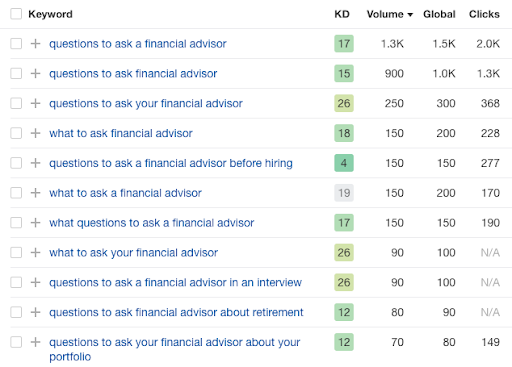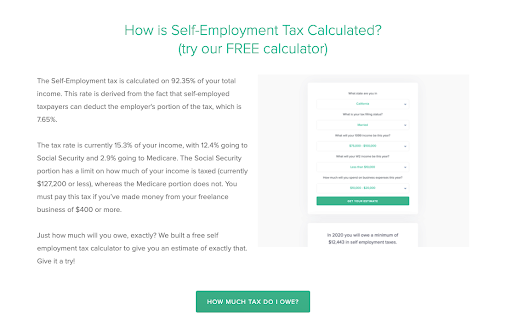Between 2016 and 2018, mobile searches related to financial planning and management grew by 70%. In the same period, mobile searches for “best credit card(s)” also grew by 70%.
The point? Financial institutions need to show up in search results to stand out from the competition and attract new customers. And content marketing is the best way for financial services to stand out in a crowded market.
Let’s take a closer look.
Why is content marketing important for financial services companies?
Content marketing is the foundation from which you can build all your other marketing strategies. Not only will content help you show up in search results, but it also brings engaged traffic to your website and demonstrates your company’s expertise. It gets your company in front of a growing digital audience that wants to learn and make informed financial decisions.
Still need more convincing? Here are five reasons content marketing is so essential for financial services companies.
1) Builds brand awareness for your company
Every time someone sees a piece of your content, they become more familiar with your company. Content marketing helps you rank for keywords relevant to your business and service so that when people search on Google or other search engines for those terms, they’ll find content from your company.
This is important because, unless your company is a household name like Bank of America, people aren’t going to search for your company directly. They’re going to search for the services they need. That’s where creating educational content that addresses your audience's pain points comes in handy. It helps get your company in front of a growing digital audience that wants to learn and make informed financial decisions.
2) Educates your target audience
The Edelman Trust Barometer found that, to the general public, financial services is one of the least-trusted industries. Part of that mistrust might stem from a lack of understanding about financial topics. For example, there is a lot of terminology that you use that’s a mystery to your customers.
Content marketing is an opportunity for you to explain complex financial concepts, processes, and terminology to help your audience better understand your products and services. If you can help potential customers learn more about your services, they’ll be more confident — both in your company and in their ability to make the best financial decisions.
3) Builds trust and credibility
Financial services can build trust with their target customers by using content marketing to:
- Educate their audience
- Answer common questions
- Address their pain points
- Help them when they need it (like when they turn to Google for help)
The more people see your company in search results, the more they’ll trust you as a credible source of information.
We’ve seen that consumers don’t widely trust the financial services industry. Only 57% of people surveyed by the Edelman Trust Barometer reported having confidence in financial companies, which suggests potential customers are likely to be especially wary of companies they don’t recognize.
4) Engages your local community
Financial services can optimize their content marketing so their website shows up in local search queries, like mortgage broker + [city] or credit union near me. By optimizing for local search, small-to-medium financial businesses can differentiate themselves from big, global brands in their market by leaning into their local community.
BrightLocal’s Local Consumer Review Survey found that in 2020, 93% of U.S. consumers searched online for a local business. And according to Think With Google, “mobile (search) queries that contain ‘insurance near me’ have grown by over 100% in the past two years." This shows just how important local search engine optimization can be for your financial services company’s content marketing.
5) Generates inbound leads
Gated content is where you require website visitors to provide their email address or contact details to access a particular piece of content and is one way you can use content marketing to generate new leads. If you’re using gated content to generate leads, it’s important to provide something of value to your audience in return for their contact details.
Examples of gated content that could work for financial services include guides and whitepapers or online tools like a retirement calculator.
What to consider when creating your financial services content marketing strategy
Content is a significant investment. It takes months to build momentum before you see substantial returns on the work you’ve put in. This is why a content marketing strategy is so important. It clarifies what you’re looking to achieve with content and how you’re planning to do that. When creating your content strategy, there are four key things to consider.
1) What are the business objectives you’re looking to achieve with content marketing?
More subscribers and web traffic are great, but how do they move the business forward? Look at the business goals your company needs to achieve, and then work out how content marketing will help you achieve them. For example, if your mortgage brokerage wants to grow its customer base by 30% this year, how does content marketing contribute to this?
2) Who is your target audience?
Before you start producing content, you need to know who you’re writing for. Your target reader is someone who buys your product or service — not their friend, colleague, or spouse. Who are they? What are the challenges they’re looking to solve with your service? And, in particular, what level of financial expertise does your audience have? Knowing this will help you create content that helps them instead of intimidating or confusing them.
3) What will you write about?
Most of your content should aim to bring in website visitors from organic search. Plan content around what people are searching for online and how your products or services tie into those search queries. For example, this screenshot from Ahrefs shows keywords relating to the phrase “ask financial advisor,” which can help you come up with ideas on content to produce based on what people are searching for:
Source: Ahrefs
4) How will you measure your content performance?
It can be difficult to attribute revenue growth to content marketing directly. Here are three metrics that help prove the value of your content:
- Month-to-month traffic growth — Your new content and existing content should bring in new website visitors, meaning your total traffic should grow each month.
- Month-to-month organic traffic growth — Regularly publishing keyword-targeted, search-optimized content should bring an uplift in organic traffic to your site.
- New leads generated — If you’re producing gated content, such as case studies or free calculators, it should generate new top-of-funnel leads for your company. Track which pieces of content are generating the most leads.
Types of content marketing for financial services companies (with examples)
If you’re stuck on “what will you write about,” here are four types of content that financial services companies can use to educate their target audience, build trust, and demonstrate their expertise.
1) Explainer content
Explainer content educates your potential customers on frequently asked questions or introductory finance topics. For example, “how-to” or “what-is” content explains a complex term, concept, or process — like applying for a mortgage or different auto financing options.
It offers your company the potential to rank for many different search terms relating to your service by answering common questions. This can help build trust with your audience. If they find your content every time they search on Google for information about virtual credit cards, they’ll see you as a credible source of information on the topic, making your financial products and services more trustworthy.
This blog post by Privacy is a great example of explainer content that answers a frequently asked question that ties into their product.
The post addresses a common concern people have that may have otherwise stopped them from using Privacy’s products. It’s optimized for search engines so that people searching for related keywords will find it:
2) Free tools and calculators
Free tools, calculators, and templates — like budget templates or a retirement savings calculator — are great ways to use content to generate new leads for your business if you require users to provide their email addresses to get their results.
They are helpful and valuable content for your audience because these tools help them understand how to complete a particular task (like paying taxes) based on their particular circumstances.
Bonsai’s self-employment tax calculator is a great example of a free calculator. It’s part of a collection of resources related to self-employment taxes.
This calculator helps users estimate how much in taxes they need to pay based on their location, earnings, and expenses. It’s part of a whole hub of resources about self-employment taxes, so users can get all the information they need in one place.
3) Thought leadership content
According to Animalz, thought leadership content is** **“rooted in your unique perspective or experience or expertise.” It focuses on sharing the perspectives, expertise, and resources with your audience to build trust and credibility and position your company as a leading authority in your industry.
Better’s Mortgage News series is a great example of how you can demonstrate authority in your space with thought leadership content. It analyzes market trends and industry developments that may affect people looking to take out a new mortgage and what that impact could be.
4) Case studies
Case studies are a great way to build trust and credibility with your audience through social proof. They come in many formats, including blog posts and videos. They can also be used to generate new leads if you produce case studies as downloadable PDFs.
Demand Gen’s 2020 Content Preferences Study found that case studies are the most popular type of content for buyers toward the end of the buyer’s journey when they’re close to deciding which product or service to purchase.
Kabbage’s Behind the business page lets their customers explain how Kabbage has supported their businesses with flexible access to the capital they need. They offer case studies aligned with the different ways they help businesses: getting started, financing, growth, and management. Each case study is titled with the customer’s name and their company name underneath to highlight the person behind the business.
Make the most of the new leads from your content marketing
Financial services can use content marketing to generate new leads through gated resources, tools, and calculators or by encouraging visitors to subscribe to your email list. Use trackable contact forms on your gated content to gather the email addresses of new leads. These forms will help you see where your traffic originated from, helping you understand which of your content marketing campaigns perform most effectively and deliver the best return on investment.

















